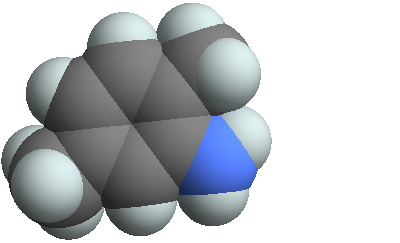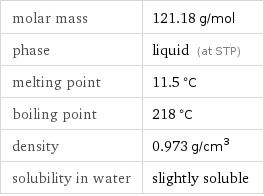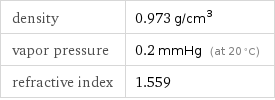Input interpretation

2, 5-xylidine
Chemical names and formulas

formula | (CH_3)_2C_6H_3NH_2 Hill formula | C_8H_11N name | 2, 5-xylidine IUPAC name | 2, 5-dimethylaniline alternate names | 2, 5-dimethylaniline | 2, 5-dimethylbenzenamine | (2, 5-dimethylphenyl)amine | 2-amino-1, 4-dimethylbenzene | 2-amino-p-xylene | benzenamine, 2, 5-dimethyl- | p-xylidine mass fractions | C (carbon) 79.3% | H (hydrogen) 9.15% | N (nitrogen) 11.6%
Lewis structure

Draw the Lewis structure of 2, 5-xylidine. Start by drawing the overall structure of the molecule, ignoring potential double and triple bonds: Count the total valence electrons of the carbon (n_C, val = 4), hydrogen (n_H, val = 1), and nitrogen (n_N, val = 5) atoms: 8 n_C, val + 11 n_H, val + n_N, val = 48 Calculate the number of electrons needed to completely fill the valence shells for carbon (n_C, full = 8), hydrogen (n_H, full = 2), and nitrogen (n_N, full = 8): 8 n_C, full + 11 n_H, full + n_N, full = 94 Subtracting these two numbers shows that 94 - 48 = 46 bonding electrons are needed. Each bond has two electrons, so in addition to the 20 bonds already present in the diagram add 3 bonds. To minimize formal charge carbon wants 4 bonds. Identify the atoms that want additional bonds and the number of electrons remaining on each atom: Fill in the 3 bonds by pairing electrons between adjacent highlighted atoms. Note that the six atom ring is aromatic, so that the single and double bonds may be rearranged: Answer: | |
3D structure

3D structure
Basic properties

molar mass | 121.18 g/mol phase | liquid (at STP) melting point | 11.5 °C boiling point | 218 °C density | 0.973 g/cm^3 solubility in water | slightly soluble
Units

Hydrophobicity and permeability properties

experimental LogP hydrophobicity | 1.83 predicted LogP hydrophobicity | 1.79 predicted LogS | -1.38
Basic drug properties

approval status | experimental | small molecule
Liquid properties (at STP)

density | 0.973 g/cm^3 vapor pressure | 0.2 mmHg (at 20 °C) refractive index | 1.559
Units

Thermodynamic properties

molar heat of vaporization | 62.8 kJ/mol specific heat of vaporization | 0.518 kJ/g molar heat of combustion | 4681 kJ/mol specific heat of combustion | 38.63 kJ/g critical temperature | 725 K critical pressure | 3.78 MPa (at STP)
Chemical identifiers

CAS number | 95-78-3 Beilstein number | 2205178 PubChem CID number | 7259 PubChem SID number | 24846569 SMILES identifier | CC1=CC(=C(C=C1)C)N InChI identifier | InChI=1/C8H11N/c1-6-3-4-7(2)8(9)5-6/h3-5H, 9H2, 1-2H3 InChI key | VOWZNBNDMFLQGM-UHFFFAOYAX RTECS number | ZE9100000 MDL number | MFCD00007743
NFPA label

NFPA label

NFPA health rating | 3 NFPA fire rating | 1 NFPA reactivity rating | 0
Safety properties

flash point | 93.89 °C autoignition point | 520 °C lower explosive limit | 1% (concentration in air)

DOT hazard class | 6.1 DOT numbers | 1711
Toxicity properties

RTECS classes | tumorigen | mutagen